Paul Gilster's Blog, page 200
June 13, 2014
Transcendence Going Interstellar: How the Singularity Might Revolutionize Interstellar Travel
Andreas Hein, who has appeared in these pages before on the subject of worldships, here speculates about a much different kind of traveling: The uploading of consciousness. Andreas is Deputy Director of the Initiative for Interstellar Studies (I4IS), as well as Director of its Technical Research Committee. He founded and leads Icarus Interstellar’s Project Hyperion: A design study on manned interstellar flight. Andreas received his master’s degree in aerospace engineering from the Technical University of Munich and is now working on a PhD there in the area of space systems engineering, having conducted part of his research at MIT. He spent a semester abroad at the Institut Superieur de l’Aeronautique et de l’Espace in Toulouse, working on the numerical simulation of the hypervelocity impact of space dust on spacecraft antennas, and also worked at the European Space Agency Strategy and Architecture Office on stakeholder analysis for future manned space exploration. Today’s essay is drawn from his chapter in the upcoming book Beyond the Boundary, to be published by the Initiative for Interstellar Studies.
by Andreas Hein

In the movie “Transcendence”, Dr. Will Caster’s consciousness, played by Johnny Depp, is “uploaded” into a quantum computer. This feat unleashes a cascade of rapidly accelerating technological changes, culminating into a “technological singularity”. It is probably the first time that the technological singularity plays a central role in a Hollywood blockbuster. However, the hypothetical concept of uploading one’s consciousness into a computer, also called “mind uploading” or “whole brain emulation”, has been a topic in science fiction for decades. Seemingly far-fetched, mind uploading might be actually not very far from reality. Recently, the European Union’s Human Brain Project has formulated its objective to simulate the human brain. With an anticipated budget of over one billion Euros, it is the largest project of this kind ever conducted. Although the Human Brain Project’s objective is to simulate the human brain, it has spurred discussions about the prospects of mind uploading. Mind uploading might have truly transformative consequences for our civilization. Among them are the potential for digital immortality and the creation of emulated minds which might transform knowledge work, as they can be copied and used on-demand for intellectually demanding tasks (Hanson, 2008a & 2008b).
Mind uploading also opens up exciting opportunities for interstellar flight.

Image: Part of a poster for the movie “Transcendence.” Credit: Alcon Entertainment / DMG Entertainment / Straight Up Films.
In this article, I will try to give a brief overview of existing concepts for using mind uploading for interstellar travel, as well as proposing novel concepts, which might radically change the way humans would travel to the stars. Furthermore, potential mission architectures are presented, having profound consequences on the way such a mission accomplishes its objectives.
First of all, I clarify what is meant by “mind uploading” in this article. “Mind uploading” is understood here as the transfer of mental content, for example long term memory, or consciousness, from the brain substrate into an artificial device, a digital, analog, or quantum artificial neural network (Sandberg & Bostrom, 2008). Once uploaded, the mental content can be “run” on the device as a simulation or simply stored. Analogously, “mind downloading” is defined as the transfer of mental content from an artificial device to brain substrate. Mind downloading goes hand in hand with the recreation of the human body in its entirety. Otherwise, mind downloading would not make a lot of sense for interstellar travel. If the whole body is up- and downloaded, this can be termed “human uploading” or “whole body emulation”. In this article, the boundaries between “mind uploading” and “human uploading” are often blurred. They are therefore considered to be exchangeable.
The main objective of manned interstellar travel is transporting humans to another star system and starting a new civilization there. The basic idea of using mind uploading for interstellar travel is to upload the human mind and/or body and to recreate it at the target destination. To jump-start a new, thriving civilization at the target destination requires the transfer of knowledge for performing all necessary activities. Transporting humans in digital form has huge benefits for interstellar travel: Firstly, it leads to extreme mass savings. No longer are large habitats and complex life-supporting systems needed. At the same time it offers the capability to “resurrect” living humans at the target destination, including their knowledge and thus culture, thus greatly facilitating the start of a new civilization. Knowledge and technology is transferred from the emulated brains at the target destination, either by education or “hard-wiring” emulations into biological brains.
Of course, one could speculate about the radical possibility of the complete replacement of biological life by artificial life. In this scenario, the spacecraft would be rather the “seed” for a non-biological civilization (Kurzweil, 2005).
Interstellar colonization concepts based on mind uploading can be categorized as shown in Table 1.
Table 1: Colonization tasks mapped to interstellar colonization concepts based on mind uploading
FunctionConcept 1 Concept 2Concept 3Concept 4Concept 5
Transport HumansHardware static storageBrain emulationsHybrid: genetic material + emulationsElectromagnetic wavesTransmit electromagnetic waves / nano spacecraft via wormholes
Construct colonyMacroscopic replicatorsMicro / nano replicators
Establish civilizationEmulations + biological humansCyborgsEmulations + biological humansEmulation cities (Hanson, 2008a, 2008b)Matrioshka brain (Bradbury, 2001)
In order to transport humans as emulations, they need to be uploaded. Uploading might be accomplished by some advanced form of scanning. Hans Moravec was one of the first to envision a form of brain scanning, by which the human brain would be incrementally uploaded in a destructive way (Moravec, 1988). Kurzweil and others envisioned non-destructive ways of uploading, for example by using nano-scale robots that scan the brain from within (Kurzweil, 2005, p.145).
Creating a copy of the brain is a daunting task. It is far more than copying just the structure of the brain, but also the structure of individual neurons and their linkages to other neurons. What is further needed is to copy the behavior of individual neurons and larger structures in the brain. This is similar to a technical system. The understanding of how the parts of a car are related to each other does not prescribe how they work together to perform the desired function of transporting passengers. It can only be inferred by painstakingly assessing how individual components and larger groups of components perform subfunctions. These subfunctions together perform the top-level function. This reverse engineering method is called a bottom-up approach. As an alternative, one can analyze functions top-down, by first decomposing the top-level functions into subfunctions. Similar reverse engineering approaches were proposed for creating brain emulations (Sandberg & Bostrom, 2008).
After an emulation has been created, it could be switched, copied, run, and also switched off as desired (Hanson, 2008a & 2008b). For an interstellar mission, emulations could be stored and first activated at the target destination. This would save energy for running emulations during flight. Having arrived at the target destination, one can imagine how activated emulations first assess the environment within the target star system and determine the best strategy for beginning colonization. Maybe a whole population of emulations is activated, which debates possible strategies and analyzes their potential outcomes. Robin Hanson imagines various types of emulations which also form hierarchies, depending on their simulation speed. Such emulation cities on Earth would consume a huge amount of power to sustain the emulations and their virtual environment in which they exist. Manipulations of the physical world are performed by various types of manipulators and robots (Hanson, 2008a & 2008b). A strategy for an interstellar mission would be the reactivation of an initial small population of emulations which make the initial decisions of how to proceed with colonization. Then, resources would be mined and processed, in order to increase computational capability and to create a larger number of emulations, which then create biological humans along with their habitats. Another option is the simultaneous transportation of zygotes and emulations.
A more advanced version of such a mission is the initial creation of an infrastructure within the target star system by using replicators and the construction of a receiver for electromagnetic signals, for example a laser beam. Once established, data for objects could be transmitted with light speed. This is the concept of teleportation. Teleportation was often deemed infeasible, as the amount of information to be transmitted for assembling a human body molecule by molecule would be prohibitive. For example, Roberts et al. argue that a total of 2.6*1042 bits are necessary for recreating the human brain (Roberts et al., 2012). The data for recreating the rest of the human body is insignificant compared to that number (1.2*1010 bits). With a data rate of about 3.0*1019 bits per second, it would take 4.85 trillion years to transmit a human. However, a close look into the assumptions made in the paper reveals that the so-called Bekenstein bound was used for calculating the data required to recreate the brain (Bekenstein, 73), (Lokhorst, 00). The Bekenstein bound describes the maximum information that is required to recreate a physical system down to the quantum level. It is doubtful that such an extremely detailed description is necessary. Current estimates for describing the brain down to a molecular level are rather in the range between 1022 – 1027 bits (Sandberg, 2008, p.80). This amount of data could be transmitted within an hour to ten years, assuming the same data rate of 3,0*1019 bits per second. Thus, teleportation might not be as far-off as suggested by the current literature. A mission architecture based on teleportation is shown in Figure 3.
One of the more speculative approaches to enable manned interstellar travel with almost no travel time is to use some form of faster-than-light approach. There is a whole plethora of conjectured faster-than light approaches (Davis et al., 2009). Sending pure data or nano probes through shortcuts in space-time is far easier than doing so with large manned spacecraft. Kurzweil speculates how microscopic wormholes might enable the transmission of data or nano probes to another place in the Universe (Kurzweil, 2005, p.354-355). A mission architecture based on this concept is shown in Figure 4.
Mission architectures
Digital interstellar missions open up a space of interesting mission architectures. Depending on the available technologies, various architectures are feasible, as shown in Table 2.
Table 2: Digital mission architectures and their enabling technologies
TechnologiesABCD
Replicator technical systemsrequiredrequiredrequiredrequired
Replicator / Grow biological systemsrequiredrequiredrequiredrequired
Brain emulationrequiredrequiredrequiredrequired
Teleportationrequiredrequired
Wormholesrequired
Architectures A to D can be seen in the figures below, along with their mission sequence.
Architecture A
1. Send replicator + emulator / storage spacecraft
2. Create colony and resurrection infrastructure
3. Create population
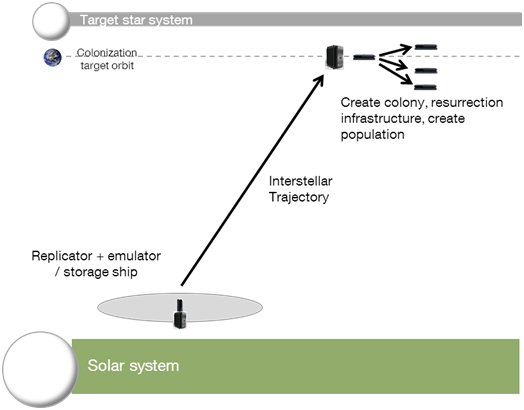
Fig. 1: Single spacecraft mission with digital and replicator payload. This so-called “bat chart” shows the mission sequence from left to right. The inclination of the arrows indicates how fast the spacecraft arrives at the target. The steeper, the faster.
This is the simplest mission architecture for an emulation interstellar mission. The spacecraft consists of the emulator payload and a replicator payload which bootstraps local resources to manufacture the initial space colony. The emulations are subsequently downloaded and human bodies are created.
Architecture B
1. Send replicator
2. Create colony and resurrection infrastructure
3. Send emulator / storage spacecraft
4. Create population
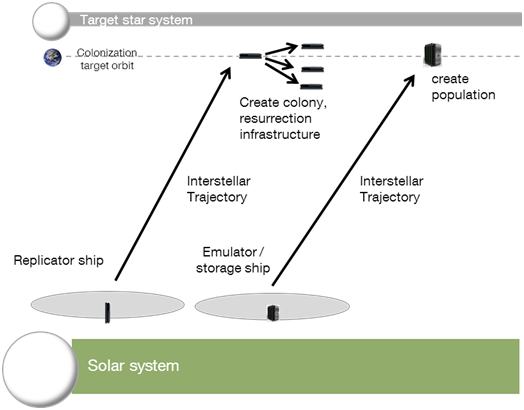
Fig. 2: Split mission with separate replicator and digital payload
Architecture B is based on two spacecraft. The replicator spacecraft is launched first, in order to initiate colony construction way before the emulator spacecraft arrives. This architecture makes sense if colony construction takes decades or centuries. The main advantage is the reduction of risk from a failure to construct the initial colony. The emulator spacecraft could be launched only if the colony is operational. Another advantage is the use of a different propulsion system for the emulator ship, allowing for a shorter trip duration than the replicator ship. A shorter trip duration reduces the risk of failures of on-board systems, which is more critical for the emulator ship as it has in principle a human payload on-board.
Architecture C
1. Send replicator spacecraft
2. Create receiver dishes in target star system
3. Receive data for creating technical systems & humans
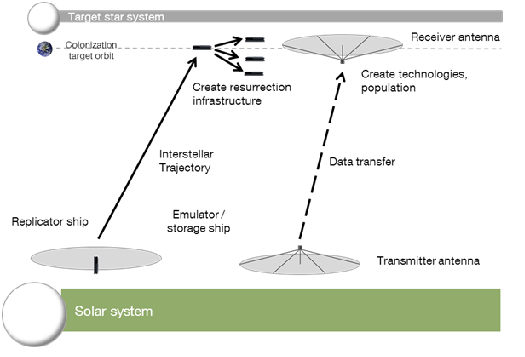
Fig. 3: Replicator mission which builds up a receiver for technologies and humans to be created within the star system
In order to teleport data, a receiver has to be constructed within the target star system first. This is done by the replicator spacecraft’s payload. Apart from the receiver, a molecular assembly facility or universal 3D-printer has to be constructed, which then recreates the original objects. The main advantage of this architecture is the travel duration for the objects transferred, as the data is transmitted is the speed of light.
Architecture D
1. Send replicator spacecraft
2. Build receiver
3. Use wormholes to transmit information to receiver
4. Create technological systems & humans
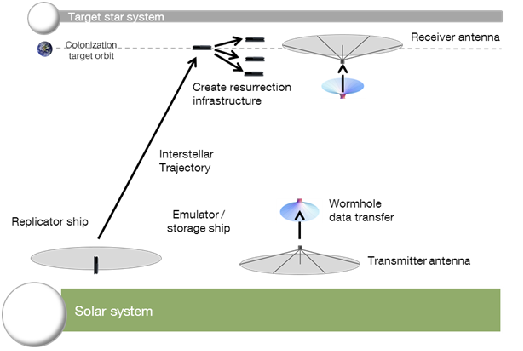
Fig. 4: Using a worm hole for transmitting data for technologies and humans with faster than light speeds
After the construction of a receiver and molecular assembly facility, data is transferred almost instantly through a worm hole or other exotic means.
Conclusions
The concept of brain emulation is often associated with the occurrence of the so-called technological singularity, which is often associated with the emergence of general artificial intelligence and its exponentially increasing capabilities. Whether or not it is reasonable to expect such a singularity to happen is the matter of intense debate among scholars (Sandberg, 2010), (Sandberg & Bostrom, 2011), (Goertzel, 2007). Personal conversations with a range of brain researchers have rather revealed a skeptical outlook on progress in creating brain emulations in the near future. Nevertheless, there is no doubt that progress is being made. Brain emulation and general artificial intelligence should not be discarded on the grounds of current or near-future infeasibility, as we are dealing with timeframes of decades to centuries until interstellar missions are conducted.
As a final remark, Launius & McCurdy point out that a posthuman civilization does not necessarily possess the motivation to conduct an interstellar mission (Launius & McCurdy, 2008, pp.218-219). Thus, one has to keep in mind that changing the human condition so profoundly will certainly have consequences for its behavior as well.
Although the prospects of mind uploading are controversial, its realization within the 21st century should not be deemed infeasible. It is even imperative to think about possible implications of this technology, as its realization would drastically change our civilization as well as it would revolutionize interstellar travel. How would it then feel to travel to the stars? After being scanned, would we suddenly wake up in a new body on an exoplanet? Would we instead pass our time in a virtual world crossing the space between the stars, finally transforming into a biological existence again? Fascinating but also somewhat chilling thoughts…
References
Bekenstein, J. D. (1973). Black holes and entropy. Physical Review D, 7(8), 2333.
Davis, E. W., & Millis, M. G. (2009). Frontiers of propulsion science. American Institute of Aeronautics and Astronautics.
Goertzel, B. (2007). Human-level artificial general intelligence and the possibility of a technological singularity: A reaction to Ray Kurzweil’s The Singularity Is Near, and McDermott’s critique of Kurzweil. Artificial Intelligence, 171(18), 1161-1173.
Hanson, R. (2001). Economic growth given machine intelligence. Journal of Artificial Intelligence Research.
Hanson, R. (2008a). Economics of brain emulations. In Tomorrow’s people – proceedings of the james martin institute’s first world forum: EarthScan.
Hanson, R. (2008b). Economics of the singularity. Spectrum, IEEE, 45(6), 45-50.
Kurzweil, R. (2005). The Singularity Is Near: When Humans Transcend Biology, Penguin Books.
Launius, R. D. (2008). Robots in space: technology, evolution, and interplanetary travel. JHU Press.
Lokhorst, G. J. (2000, May). Why I am not a super-Turing machine. In Hypercomputation Workshop, University College, London (Vol. 24).
Moravec, H. (1988). Mind children. Cambridge, MA: Harvard University Press.
Sandberg, A., & Bostrom, N. (2008). Whole brain emulation: A roadmap. Future of Humanity Institute, Oxford University. Available at: http://www.fhi.ox.ac.uk/brain-emulation-roadmap-report.pdf Accessed July, 3, 2010.
Sandberg, A. (2010). An overview of models of technological singularity. In Roadmaps to AGI and the future of AGI workshop, Lugano, Switzerland, Mar. 8th. http://agiconf. org/2010/wp-content/uploads/2009/06/agi10singmodels2. pdf.
Sandberg, A., & Bostrom, N. (2011). Machine intelligence survey. Technical Report, 2011-1. Future of Humanity Institute, University of Oxford. www.fhi.ox.ac.uk/reports/2011-1. pdf.






June 12, 2014
The Worldship of 1953
Les Shepherd’s 1952 paper “Interstellar Flight” appears in the Journal of the British Interplanetary Society,” a fitting place given Shepherd’s active involvement in the organization. He would, in fact, serve the BIS as its chairman, first succeeding Arthur C. Clarke in that role in 1954, and returning in 1957 and again in 1965 for later terms of office. “Interstellar Flight” is one of those papers that turns people in new directions after they have read it, and we can see the gradual acceptance of travel between the stars as a possibility that does not violate the laws of physics beginning in its pages.
Much less heralded but more widely seen was an adapted version of “Interstellar Flight” that appeared in Science Fiction Plus in April of 1953. The magazine was a revival of Hugo Gernsback’s career as a science fiction publisher that ran for seven issues before its demise in December of the same year. Gernsback’s name was revered in science fiction circles as the founder of Amazing Stories in 1926, and for his later career with Science Wonder Stories and Air Wonder Stories, magazines he would eventually merge before selling his interest entirely in 1936. In contrast to these earlier titles, Science Fiction Plus was printed on slick paper and featured glossy covers, though many of the writers Gernsback used had worked with him in the Amazing Stories days.

Science Fiction Plus was an interesting venue for Shepherd because it exposed his work to an audience that had already encountered science fiction treatments of interstellar concepts like the generation ships he wrote about in the following paragraph:
At first sight the idea of advancing mankind’s frontiers to points requiring hundreds or even thousands of years to reach, might seem hopeless. It cannot indeed be regarded as a particularly satisfactory picture of interstellar exploration. However, regarded in terms of geological eras, centuries or millennia are small intervals, and provided that human life can be sustained in exploring vehicles for long periods, there is no reason why interstellar expansion should not proceed on this basis.
I can envision the Gernsback audience soaking this up, familiar as many of these readers would have been with stories like Robert Heinlein’s “Universe” and Don Wilcox’s “The Voyage that Lasted 600 Years.” The latter, which appeared in Amazing Stories in October of 1940, tells the tale of one Gregory Grimstone, who spends an interstellar voyage in a state of hibernation, but is wakened once every hundred years as the ‘Keeper of Traditions,’ the one contact the crew still has with the Earth left behind many generations before. Here we have the same theme of lost knowledge and a crew gradually losing the meaning of their journey that we find in Heinlein’s Orphans of the Sky and a variety of later tales.
Image: Pioneering physicist Les Shepherd, whose work on interstellar flight has influenced generations of subsequent researchers.
The magnitude of the journey in terms of space and particularly time is well captured in Shepherd’s essay:
The author is not competent to deal with the biological problems of life on an interstellar vehicle undertaking a voyage lasting for a millennium. Obviously they would assume a magnitude quite as great as the engineering problems involved. In the normal way, some thirty generations would be born and would die upon the ship. It would be as though the vessel had set out for its destination under the command of King Canute and arrived with President Truman in control. The original crew would be legendary figures in the minds of those who finally came to the new world. Between them would lie the drama of perhaps ten thousand souls who had been born and had lived and died in an alien world without knowing a natural home.
Now, as to those italics. They’re clearly Gernsback’s, a suspicion natural to anyone familiar with his editorial style. The JBIS paper containing the identical passage has no italics at this point, and it’s clear that Gernsback wanted to drive home the science fictional ‘sense of wonder’ of Shepherd’s remarks with his typesetting. I’m not sure the audience needed the hint. I still find the idea of multiple generations living and dying aboard an interstellar craft to be mind-boggling even when presented in the lean text of the average scientific paper.
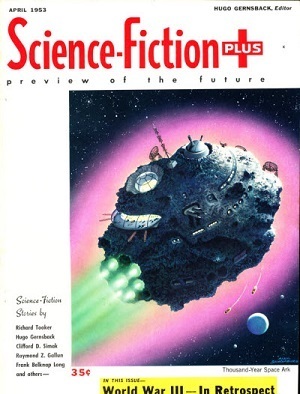
Shepherd would go on to discuss worldship issues ranging from population control — for humans and journeying animals — as well as the huge problem of life-support systems in a self-contained world. He saw the only feasible way to make a journey like this would be in a ship of gigantic proportions, and for him, that meant hollowing out ‘a small planetoid,’ one of perhaps a million tons (excluding the weight of propellants and fuel). He believed artificial gravity should be induced by rotating the ship, and he pondered the question of maintaining an atmosphere over the course of ten centuries. On matters of sociology, he said this:
The passage of perhaps thirty generations would pose major problems of a sociological nature. The control of population would be only one of many. Children could only be born according to some prearranged plan, since overpopulation or underpopulation would be disastrous. The community would be subjected to a degree of discipline not maintained in any existing community. This isolated group would need to preserve its civilization, and hand on precious knowledge and culture from generation to generation and even add to the store of science and art, since stagnation would probably be the first step to degradation.
I don’t want to give the impression that Shepherd’s “Interstellar Flight” is solely about worldships, because the original JBIS paper was wide in its scope, examining nuclear fission, fusion and ion propulsion and going into depth on the possibilities of antimatter. Giovanni Vulpetti has pointed out that antimatter had been little studied in terms of propulsion at the time Shepherd wrote, and it was Shepherd who brought the concept out of the realm of science fiction and into the realm of serious physics with this single paper. We owe much to “Interstellar Flight,” published a year before Eugen Sänger’s famous paper on photon rockets, and I think Shepherd was wise to let Gernsback publish a version of it that could reach a broad popular audience.
As for Gernsback, he was canny to bring a serious study of interstellar travel into the pages of his young magazine, although not as successful when it came to story selection. Science fiction historian Mike Ashley has noted a certain archaism in the fiction here because of Gernsback’s reliance on writers from the previous generation. Even so, one Science Fiction Plus story still stands out. It’s Clifford D. Simak’s “Spacebred Generations,” from the August, 1953 issue. As the title implies, this is a worldship story that flows naturally out of Shepherd’s own speculations. We’ll take a closer look at what Simak has to say in an upcoming post.
Les Shepherd’s original paper on interstellar propulsion is “Interstellar Flight,” JBIS, Vol. 11, 149-167, July 1952, from which the article in Science Fiction Plus was adapted.






June 11, 2014
Cultural Evolution: The View from Deep Space
I didn’t have the chance to meet Mark Lupisella at the first 100 Year Starship symposium in Orlando, but the publication of Cosmos & Culture: Cultural Evolution in a Cosmic Context in 2013 made me wish I had sought him out. Co-edited with Steven J. Dick (about whom there are so many interesting things to say that I’ll have to carry over into a future post with them), Cosmos & Culture offers essays from scientists, historians and anthropologists about the evolution of culture both on Earth and, most likely, beyond it.
These are, of course, issues we’ve been considering recently in the work of Cameron Smith and Kathleen Toerpe, and in a broader sense they inform many of the SETI and astrobiology discussions we have here. Then Clément Vidal, who is an author and a post-doctoral researcher at the Free University of Brussels, passed along the paper I missed in Orlando, Lupisella’s “Cosmocultural Evolution: Cosmic Motivations for Interstellar Travel.” To be fair to myself, we all missed plenty of papers at the first 100YSS, because there were five simultaneous tracks and it was impossible (at the current state of technology) to be in more than one place at a time.
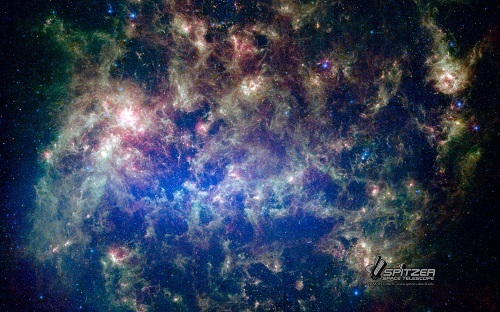
Image: A Spitzer infrared view of the Large Magellanic Cloud, a satellite galaxy to the Milky Way. How we define the human role in a cosmos of such immensity has ramifications throughout our culture. Credit: Spitzer Space Telescope/JPL.
I want to draw on Lupisella’s work this morning because it intersects with an issue I often deal with: How do we state a rationale for expansion into the cosmos? Lupisella discusses a very interesting ‘cosmocultural evolution’ that I’ll get to in a moment, but let’s focus on the motivations for going off-planet that inform any discussion about space. I take it for granted, for instance, that one key driver for a long-term human presence in space is simple survival, the universe being a dangerous place, and our Solar System littered with evidence in the form of space debris and cratered terrain of what can happen when one astronomical body runs into another.
Not everyone agrees with this motivation. I’ve written before about one dinner party where, in the midst of a discussion about everything but the future, one of the guests suddenly asked me why I spent so much time writing about space. It soon became clear that the consensus at the dinner table held that money spent on space was wasted by being diverted from pressing needs on Earth. After I had explained my view that our species needed to insure itself against future catastrophe, my first interrogator said, “Why? I would think that if we found a huge object headed for our planet, we would be doing the universe a favor by letting it hit us and getting it over with.”
So you can’t count on survival as a trump card. And by the way, trying to get past the attitude just cited is probably impossible, because anyone that misanthropic isn’t going to give ground even when reminded that if he did let an incoming asteroid hit the Earth, he would be signing not just his own death warrant but those of his grandchildren and everyone else’s grandchildren as well.
Lupisella sees interstellar flight as “the ultimate insurance policy,” but he brings to the question an added ethical dimension. We should consider our survival as necessary, in this view, because of the possibility that we may ultimately play a role in the broader evolution of the universe. So maybe we want to thrive and prosper not just for ourselves but for the sake of the meaning we can bring to life’s experience in the cosmos.
I find this a heartening view, but let’s add to it some other factors Lupisella pointed to in Orlando. A human presence in space sets up the conditions for countless new experiments in culture and philosophy, which means experiments in everything from social organization to means of governance, all of which would be interesting in and of themselves as well as providing data that could be of use for those remaining on the home world. The cultural experimentation this implies could also be complemented by new contexts for biological evolution — Freeman Dyson has written often about what could happen to our species as we begin to live in radically different environments and essentially begin to fork into various branches of homo sapiens, while the aforementioned Steven J. Dick has explored the emergence of post-biological intelligence.
Cultural diversity flows naturally out of all this, surely healthy for the species, but so does what Lupisella calls a ‘cosmic promotion,’ the reverse of the great demotions we have undergone throughout history as we adjusted our views of the cosmos. We’ve accustomed ourselves to being dethroned from the center of the universe, from being the place around which the Sun revolves, from being at the center of the galaxy, from being in the galaxy as we learned how many of them there are, and so on. Lupisella’s view of cosmocultural evolution suggests that although life, intelligence and culture could arise by chance, they still might have cosmic significance, or as he says, “Modest origins do not imply modest potential.”
Here’s the argument in a nutshell:
If the universe didn’t have value and morality prior, it does now. If it didn’t have meaning and purpose prior, it may now. If it didn’t have intentional creativity prior, it does now. We may be a very small part of the universe that arose by chance, but nevertheless, strictly speaking, the universe now contains morality and a kind of intentional creativity it may not have had prior to the emergence of cultural beings like us. We cultural beings, in some nontrivial sense, make the universe a moral and increasingly creative entity, however limited that contribution may be for now. Increasingly, human culture is expanding its circle of creativity and moral consideration. Perhaps interstellar travel can help expand a circle of moral creativity to the whole of the universe.
Does this remind you of anyone? For me, this is strikingly similar to Michael Michaud’s calls to bring meaning to the cosmos. In one of our dialogues in these pages (see Spaceflight and Legends: A Dialogue with Michael Michaud), the author and diplomat said this:
The moral obligation to assure the survival of intelligence is not imposed on us by gods or prophets, but by our own choices. Call that anthropocentrism if you will. I prefer to think of us as independent moral agents, perhaps the only ones in the galaxy. Until and unless we discover another technological civilization, we have a unique responsibility to impose intention on chance.
I love that phrase ‘to impose intention on chance’ and have used it in several talks. You may have run into Carl Sagan using language a bit like this. When pressed on what happens to humanity in a universe that can seem without meaning, Sagan would reply “Do something meaningful.” I take this to mean, whatever your views, whatever your angle on life, shape events toward a meaningful outcome. Don’t, in other words, let that asteroid hit the Earth. And no matter how bewildered you may be about your place in the cosmos, go forward and do your best.
I draw strength from Lao Tzu: “You accomplish the great task by a series of small acts.” The things we do every day to give meaning to our lives matter. Make them count.
Lupisella notes that in 2007, a panel of experts meeting at the Future of Space Exploration Symposium at Boston University recommended that a 50-year global vision be developed to guide future human space efforts. I am all for such long-term thinking and believe it dovetails nicely with our growing understanding of the meaning we can bring into being as we work. How energizing it is to see the cultural issues of future spaceflight in active discussion. Clément Vidal, by the way, has a book of his own coming out. I look forward to seeing The Beginning and the End: The Meaning of Life in a Cosmological Perspective, just published by Springer.






June 9, 2014
Putting the ‘Giggle Factor’ to Rest
Can we overcome our preconceptions about extraterrestrial life? Kathleen Toerpe thinks the answer is yes, for we’re moving from the era of ill-informed jokes about ‘little green men’ to a widening appreciation of our place in the cosmos. Dr. Toerpe is the Deputy CEO for Programs and Special Projects at the Astrosociology Research Institute and editor of The Journal of Astrosociology. She also serves as a NASA/JPL Solar System Ambassador, one whose educational efforts on behalf of space exploration have revealed that the younger generation is familiar with and inspired by the subject, a fact that gives this essay its welcome patina of optimism. The recent hearings on SETI in the U.S. House of Representatives show that, for some at least, old attitudes die hard, but ongoing research into astrobiology and SETI is likely to make the ‘giggle factor’ seem positively prehistoric within our lifetimes.
by Kathleen D. Toerpe, PhD

Flip through any newsfeed these days, and it seems that humanity is experiencing an extraterrestrial renaissance. No, I’m not talking about the reboot of the Star Wars franchise, though that reawakening has been long overdue. Rather, I’m referring to the deservedly serious discourse in both the popular and scientific press over the search for extraterrestrial life (henceforth, shortened to “ET” – with both apologies and credit to Mr. Spielberg).
Two prominent examples here make my point.
On May 22, 2014, NASA released a free downloadable eBook edited by SETI social scientist, Douglas A. Vakoch, titled Archaeology, Anthropology, and Interstellar Communication. This fascinating book (which consumed much of my attention the recent Memorial Day weekend) examines the multilayered and interdisciplinary approaches that social scientists employ to anticipate how we might communicate with intelligent beings from another planet. Hearkening to analogs in Mayan hieroglyphs, music theory, Neanderthal research, and decoding extinct Earth languages (among several other fascinating analogs), this compilation of conference presentations teases out the seemingly intractable challenges of decoding and interpreting a message sent from ET and the possibilities of composing our own message in response.
A day earlier, on May 21, 2014, Seth Shostak and Dan Werthimer, two of SETI’s most eminent radio astronomers, testified before the House Committee on Science, Space, and Technology about “Astrobiology and the Search for Life in the Universe.” The hearings focused on the progress made by radio and optical astronomy in detecting extraterrestrial life in the universe, and followed a similar hearing in December of 2013 that focused on the search for alien microbial life. Both Shostak’s and Werthimer’s prepared remarks thoroughly updated the House Committee on the rationales for the search, the search modalities, and the successes, challenges, and future direction of SETI investigations: atmospheric investigations into exoplanetary biochemical signatures, optical SETI recording intermittent pulses of light, panchromatic searches canvassing even broader swaths of the electromagnetic spectrum, even eavesdropping on our exoplanet neighbors for inadvertent signal leaks.
Serious science all around. But a final question, posed by the hearing’s Charter, asked the scientists to speak to the “public interest in the topic.” While Werthimer’s written testimony offered examples of SETI-inspired poetry and citizen science projects (the latter not surprising since the solidly popular and successful SETI@home project is headed out of Werthimer’s UC-Berkeley office), Shostak revealed the five-hundred-pound gorilla lurking in the background. This particular gorilla is commonly known as the “Giggle Factor.”
It is the immediate response many people have when the subject of ET and aliens arise. That under-the-breath chortle, that second look as if to say, “You’re really serious about this?” Psychologist and astrosociologist Albert Harrison analyzed it in his 2005 paper, “Overcoming the Image of Little Green Men: Astrosociology and SETI” and warned especially early-career SETI researchers to “be prepared . . . to risk ridicule . . . and public censure.” It was this same attitude that unfortunately earned SETI research that infamous 1979 “Golden Fleece Award” from former Wisconsin Senator William Proxmire. (Proxmire later recanted, but the damage to SETI’s reputation was done.) I suspect that every serious SETI researcher from the earliest pioneers to today’s practitioners has faced their peers’ and even their audience’s giggles. But I’m going to echo Shostak’s optimistic prediction to the House committee on the imminent discovery of ET life, and likewise guess that the Giggle Factor “is going to change within everyone’s lifetime in this room.”
What gives me the confidence to predict the demise of the Giggle Factor?
One simple word. Children.
One of the many “hats” I wear is as a volunteer NASA/JPL Solar System Ambassador. That is an auspicious-sounding way of saying that I present programs on space research and exploration to anyone in my community who wants to listen to me. Schools, scout troops and packs, senior centers, college classes, library programs, astronomy groups, radio interviews, church luncheons are all some of the places where I and my fellow Ambassadors carry the message of outer space to the public. And I’ve heard my share of giggles when I discuss Kepler exoplanetary discoveries, the Mars Curiosity Rover, and astrobiology research. But here’s the thing: the little kids aren’t laughing. Not a giggle. They wiggle and squirm, they want to play with the beach ball-like planets I bring with me, and they always want to know how much longer until snack time—but they don’t giggle. Not a chortle. Not a guffaw. Instead, there are a lot of wide eyes and dropping jaws when I describe the enormity of space and the possibilities of extraterrestrial life.
In a program I created called “Hello Out There!” we cover the science on Kepler and Curiosity and the Voyager probes, then the kids do their favorite part: composing their own messages on a cardboard “Golden Record” that they take home to share with their families. If Doug Vakoch would like to know what the scientists of tomorrow are most interested in telling ET about, it is . . . drum roll . . . their pets! In my informal review of the times I’ve presented this program (and I’m doing it with another 200 or so children this summer!) children want to tell ET about their pets, their siblings, their parents, and their favorite foods. Perhaps not quite the esoteric mathematical or chemical equations many active-SETI or messaging groups discuss sending, but it hearkens back to the more intimate and simply human messaging of the real-life Voyager recordings.
In his analysis on applying the techniques of archaeology to SETI, archaeologist and NASA e-book contributor Paul Watson concluded that we might be trapping ourselves in an “intellectual context” – our inability to overcome our preconceptions about alien life. Perhaps this is where an analysis of the Giggle Factor best finds its final resting place—as a cultural preconception. Even some of the House committee members couldn’t resist the urge to cast SETI in what Shostak earlier in the hearing had referred to as a “punchline.” House members’ questions about Ancient Aliens, Project Blue Book and UFO visitations, and whether or not ET likes the Beatles songs we’ve been sending out in space all seemed sadly discordant with the official formalities of a Congressional committee hearing. The Giggle Factor dies hard for us adults.
Committee Chairman Lamar Smith’s (Texas) comment that “finding other sentient life in the universe would be the most significant discovery in human history” is no melodramatic hyperbole. The sheer discovery of even microbial life will be far-reaching, especially if it provides confirmatory evidence of an independent DNA structure. It is even more difficult to exaggerate the human impact of the discovery of intelligent extraterrestrial life, though as astrosociologists, I and my colleagues try hard to imagine and anticipate it. It would, in Shostak’s words, “calibrate our place in the intellectual universe.” Even finding nothing will be worth the search, since it would reaffirm, according to Werthimer, that “life on this planet . . . is very precious.” Indeed it is, whether or not we ever hear from ET!

Image: Meeting of the House Committee on Science, Space, and Technology about “Astrobiology and the Search for Life in the Universe.” Credit: Library of Congress.
There is serious work to be done to prepare for the likely detection of extraterrestrial life—by both scientists and social scientists alike. Computing power needs to be enhanced to deal with the massive volume of data being acquired; more sensitive land and sky-based instruments are needed to listen and peek in on the cosmos; media protocols to govern public disclosure of a putative signal detection need to be reviewed, revised and updated; public policy regarding ownership of and access to extraterrestrial microbial samples needs to be negotiated; and — my personal research field — more analysis is needed into the readiness of Earth societies and institutions to assimilate the likely knowledge that we are not alone. And this just scratches the surface of our SETI to-do list!
Once exiled to the fringes of legitimate scientific inquiry by the Giggle Factor, the search for extraterrestrial life has gained new momentum, focus, and funding as the search broadens to encompass the search for microbial, in addition to intelligent, life. In the end, it may be the children who lead the way into a new future for SETI. In his opening statement, Committee Chair Smith reminded the high school students in attendance at the hearing that day that one of the hearing’s purposes is “to inspire students today to be the scientists of tomorrow.” And the noticeable lack of giggling in the room was magic to my ears.
———–
Kathleen Toerpe can be reached at ktoerpe@astrosociology.org and can be found at @ktoerpe on Twitter.
The video of the House Committee on Science, Space, and Technology’s hearing on “Astrobiology and the Search for Life in the Universe,” and the participants’ written statements are available at http://science.house.gov/hearing/full-committee-hearing-astrobiology-and-search-life-universe
Albert Harrison’s 2005 paper, “Overcoming the Image of Little Green Men: Astrosociology and SETI” is available at http://astrosociology.com/Library/PDF/submissions/Overcoming LGM_Harrison.pdf
Information on the NASA/JPL Solar System Ambassador program is available at http://www2.jpl.nasa.gov/ambassador/






June 6, 2014
Kepler-56: Misaligned Planets Around a Swelling Star
Although I’m sure I’ll refer to various papers presented at the American Astronomical Society this week in future entries, I’ll close our current look at the Boston meeting with word of two planets that will be falling into their star in short order (at least as astronomers measure time). Kepler-56b and Kepler-56c have a predicted era of death, some 130 million and 155 million years from now respectively. I can’t think of any other exoplanets about which we’ve been able to make such statements, making this a system worth watching as we ponder our own Sun’s future.
Just as the Sun will one day enlarge to red giant status, threatening the inner planets, so Kepler-56 is growing, already reaching four times the size of the Sun. The star has a long way to go as it continues its outward expansion, and the two planets in question are in a perilous position, with Kepler-56b orbiting the host star every 10.5 days, and Kepler-56c every 21.4. Gongjie Li (Harvard-Smithsonian Center for Astrophysics) and team have worked the number’s on the star’s evolution, leading to this prediction about the inner worlds’ demise.
You may recall this system as the first multi-planet system to be found with a tilt, as the orbits of the two inner planets are tipped from the star’s equator. Li told her session at the AAS conference that while the inner planets will be gradually destroyed by the star, heated enough to boil off any atmospheres and stretched by stellar tides along the way, a third known planet in this system, Kepler-56d, will be far enough out to survive. The latter is a gas giant in a 3.3 year orbit, and the researchers now believe that its orbit is tilted relative to the star as well. Such systems demand explanation since we would expect that planets formed from the same gas and dust disk as their host star would orbit in the plane of the star’s equator, as we see in our own system.
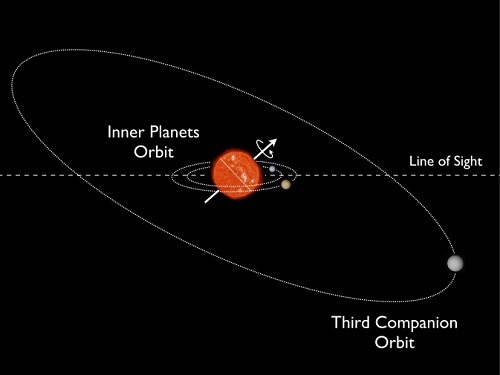
Image: Graphical sketch of the Kepler-56 system. The line of sight from Earth is illustrated by the dashed line, and dotted lines show the orbits of three detected companions in the system. The solid arrow marks the rotation axis of the host star, and the thin solid line marks the host star equator. Credit: NASA GSFC/Ames/D Huber.
Li pointed out in Boston that finding the inclination of the outer companion was important in helping us learn about the processes that produced the planetary misalignments. Last October I wrote about Daniel Huber’s work at NASA Ames involving the misalignment of the Kepler-56 inner planets with the host star. We do know of systems where ‘hot Jupiters’ are found that are not aligned with the equatorial plane of their hosts. Is this the result of planetary migration and chaotic close encounters with other planets in the system? If that is the case, then multi-planet systems without hot Jupiters should not show misalignment with the host star.
But we have no hot Jupiters around Kepler-56. Huber’s team used radial velocity measurements from the HIRES instrument at the Keck 10-meter telescope to study the system, seeing the signature of a third planet in a wide orbit (Kepler-56d) that was likewise misaligned from the equatorial plane of the star. It’s that outer planet that could in Huber’s view, have torqued the orbits of the inner planets out of the star’s equatorial plane. From the paper:
The inner planetary orbits would stay aligned with one another because of strong coupling between their orbits, resulting in a misalignment of the two co-planar transiting planets with the host star. Dynamical simulations that include a third companion in an eccentric orbit inclined to the equatorial plane of the host star confirm that such a mechanism can reproduce the architecture of the Kepler-56 system.
At 3000 light years from the Earth, Kepler-56 turns out to be a fascinating system. Huber found the rotation axis of the star tilted about 45 degrees to our line of sight at the same time that we were seeing the two transiting inner planets (Kepler-56d was detected solely by radial velocity methods). Both Li’s and Huber’s earlier work point to misalignment like this not being caused by hot Jupiters, and leave open for study how Kepler-56’s tilting mechanism could be at play around other stars. The important work ahead is to further constrain the inclination of the outer planet, Kepler-56d.
The Huber paper is “Stellar Spin-Orbit Misalignment in a Multiplanet System,” Science Vol. 342, No. 6156 (18 October 2013), pp. 331-334 (abstract).






June 5, 2014
Three Regimes of Planet Formation
On Tuesday I mentioned the work of Lars A. Buchhave, an astronomer at the Harvard-Smithsonian Center for Astrophysics (CfA), in connection with the Kepler-10c discovery. The latter is the so-called ‘mega-Earth’ now found to be seventeen times as massive as our own planet, with a diameter of about 29,000 kilometers. A larger population of solid planets with masses above 10 times that of Earth was suggested in the Kepler-10c paper (see Introducing the ‘Mega-Earth’ for more on this), with reference to Buchhave’s ongoing work.
Let’s take a closer look at what Buchhave is doing, because the intriguing fact is that planets four times the size of Earth and smaller comprise about three-quarters of the planets found by the Kepler mission. How large a role does the metallicity of the host star play in planet formation?
At the ongoing meeting of the American Astronomical Society in Boston, Buchhave explained his research methods, which involve measuring ‘metals’ — in astronomical parlance the elements heavier than hydrogen and helium — in stars hosting exoplanets. His team analyzed more than 2000 high-resolution spectra of Kepler Objects of Interest, yielding the metallicities and other parameters of 405 stars orbited by 600 exoplanet candidates.
A statistical examination of the results followed, with this outcome: Planet-hosting stars fall into three groups that can be defined by their compositions. Buchhave’s team found two dividing lines, one at 1.7 times Earth’s radius, the other at 3.9 times the radius of Earth. The inference is that planets smaller than 1.7 Earth radius are completely rocky, while those above 3.9 Earth radius are most likely gas giants. [Addendum: See kzb's comment below re a mistake I made in the initial version of this post.]
That interesting region between 1.7 and 3.9 times the size of Earth is where we find the so-called ‘gas dwarfs,’ planets whose cores accreted gas from the protoplanetary disk but failed to grow into gas giants of Jupiter-class or larger. Says Buchhave:
“It seems that there is a ‘sweet spot’ of metallicity to get Earth-size planets, and it’s about the same as the Sun. That makes sense because at lower metallicities you have fewer of the building blocks for planets, and at higher metallicities you tend to make gas giants instead.”
From the paper:
…the observed peak in the metallicity–radius plane at 1.7R⊕ suggests that the final
mass and composition of a small exoplanet is controlled by the amount of solid material available in the protoplanetary disk. A higher-metallicity environment promotes a more rapid and effective accretion process, thereby allowing the cores to amass a gaseous envelope before dissipation of the gas. In contrast, lower-metallicity environments may result in the assembly of rocky cores of several Earth masses on timescales greater than that inferred for gas dispersal in protoplanetary disks (
To produce small, terrestrial worlds, then, stars with metallicities similar to the Sun are favored, while stars with gas dwarfs are likely to be those that are slightly more metal-rich. The stars most likely to produce gas giants contain the most metals, generally fifty percent more than the Sun. The finding is intriguing but comes with the caveat that Kepler is best at finding planets relatively close to their star, and the metallicity thesis needs to be tested over a wider range of orbits.

Image: Three kinds of planetary outcome are suggested by the metallicity of the host star, according to new work by Lars A. Buchhave and team. Credit: David Aguilar, CfA.
Whether or not Buchhave’s work can explain a Kepler-10c will depend upon gathering a larger sample of such worlds to work with. But so far his analysis implies that there is no evident cutoff in size for rocky worlds, the data showing that the mass and radius indicating the transition from rocky to gaseous planets should increase with orbital period:
Although additional data are required to confirm this relationship, the fit is apparently consistent with a critical core mass that increases with orbital period and an atmospheric fraction of 5%… If correct, this predicts the existence of more massive rocky exoplanets at longer orbital periods.
Thus the farther a planet is from its star, the larger it can grow before the accretion of a thick atmosphere turns it into a gas dwarf. When we have the observational tools to examine a wide range of planets in outer-system orbits, we may be able to confirm or refute Buchhave’s suggestion that truly massive ‘super-Earths’ like Kepler-10c may not be uncommon.
The paper is Buchhave et al., “Three regimes of extrasolar planets inferred from host star metallicities,” Nature 509 (29 May 2014), pp. 593-595 (abstract / preprint).






June 4, 2014
Probing an Ancient Planetary System
The red dwarf known as Kapteyn’s Star — the name comes from the 19th Century Dutch astronomer Jacobus Kapteyn — is about thirteen light years from Earth in the southern constellation of Pictor, close enough that a small telescope can pick it out. Kapteyn’s efforts at cataloguing the star in 1898 revealed that it had the highest proper motion of any star then known, a position it lost with the discovery of Barnard’s Star in 1916. Because I find stellar encounters interesting, I’ll note that about 11,000 years ago, Kapteyn’s Star would have come within seven light years of the Sun. It has been moving away from us ever since.
Kapteyn’s Star belongs to the galactic halo, a dispersed population of stars on elliptical orbits that wraps around the galactic disk and bulge. It is the nearest known halo star to the Sun. We now know, through the efforts of an international research team, that at least two planets are found here. Kapteyn c is a ‘super-Earth’ with an orbit of 121 days, while Kapteyn b comes in at about five Earth masses and orbits the star every 48 days, potentially making it warm enough for liquid water to exist on the surface. Bear in mind that this is the 25th nearest star to the Sun, a star with a history that evidently includes birth in an original dwarf galaxy now known as Omega Centauri, which was long ago absorbed and disrupted by its encounter with the Milky Way.
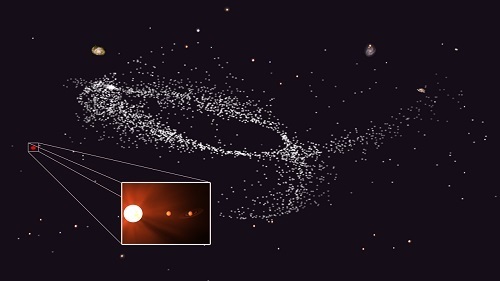
Image: Kapteyn’s Star and its planets likely come from a dwarf galaxy now merged with the Milky way. The bottom right panel shows characteristic streams of stars resulting from such a galactic merging event. Credit: Victor Robles, James Bullock, and Miguel Rocha at University of California Irvine and Joel Primack at University of California Santa Cruz.
The paper explains this intriguing background and estimates the star’s age:
The age of Kapteyn’s star can be inferred from its membership to the Galactic halo and peculiar element abundances (Kotoneva et al. 2005). The current hierarchical Milky Way formation scenario suggests that streams of halo stars were originated as tidal debris from satellite dwarf galaxies being engulfed by the early Milky Way (Klement 2010, and references therein). This scenario is supported by the age estimations of the stars in the inner halo (~10-12 Gyr, Jofré & Weiss 2011), and globular clusters. The work by Eggen and collaborators… established the existence of such high-velocity, metal-poor moving groups in the solar neighborhood. Kapteyn’s star is the prototype member of one of these groups…
So we’re dealing with an ancient star with an age not likely to be less than 10 billion years, and perhaps much older (the obvious upper cut-off being 13.7 billion years). The paper speculates that detecting two super-Earths around Kapteyn’s Star is consistent with the idea that low-metallicity stars tend to produce low-mass planets rather than gas giants, an idea supported by the small number of low mass planets found in radial velocity searches of metal-rich stars.
It’s also interesting to consider, as the paper does, that at the likely age of the Kapteyn’s Star system, most G and K dwarfs would be evolving away from the main sequence into giants, which would make detecting planets around them through Doppler methods all but impossible because of the high level of solar activity. The result: If we want to learn about the oldest planetary systems in the galaxy, we’ll need to turn to low-mass stars like this one, which remain on the main sequence and will stay there for a long time to come.
If you’re a science fiction fan, you’ll want to check out this news release from the University of London, which interweaves within the text a short story by Alastair Reynolds called ‘Sad Kapteyn.’ The tale describes in just a few paragraphs the arrival of a robotic interstellar probe at the Kapteyn’s Star planetary system. Reynolds is always worth reading (the Revelation Space novels in particular), and I quote him here as he recounts the AI probe’s discovery of a long-dead civilization on Kapteyn b:
“Continent-sized craters mar Kapteyn b, and I wonder if they speak of some truly awesome catastrophe – a cosmic accident, or something worse? Whatever the case, the builders of these cities are long gone. Perhaps they were dead even before Kapteyn’s star was snatched from the clutches of its mother galaxy.
“At the risk of inferring too much from too little data, I can’t help indulging in a little speculation. I too was the product of a technological civilisation, with the capability to transform a planet, to colonise other moons and worlds, to build daunting structures. The people of Kapteyn b were clearly more advanced than you, my own builders – but given time, you too could have transformed a world in this manner.
“Something to think about, isn’t it?”
The paper is Anglada-Escudé et al., “Two planets around Kapteyn’s star: a cold and a temperate super-Earth orbiting the nearest halo red-dwarf,” accepted at Monthly Notices of the Royal Astronomical Society (preprint).






June 3, 2014
Introducing the ‘Mega-Earth’
Building public interest in deep space is a long-term goal for most of us in the interstellar community, and the release of the film Interstellar this fall may set off a new round of discussion among reviewers and movie fans alike. Also helpful is the DVD release of the Neil deGrasse Tyson Cosmos series, given Tyson’s performance and the stunning visuals that communicate the majesty and power of the universe around us.
But I think it’s encouraging that while these blockbuster media releases work their magic, what used to be staid scientific conferences frequented only by specialists are turning into media events of their own. The American Astronomical Society is currently meeting in Boston, with exoplanet papers that I’m already seeing discussed well outside the usual venues. The more we see the excitement and sheer scope of the exoplanet hunt communicated to the public, the more likely we’re building the kind of interest among young people that may one day turn into scientific careers and — dare I say it — funding for missions that will fly beyond our system’s edge.
Maybe Dimitar Sasselov (Harvard-Smithsonian Center for Astrophysics) had a bit of media buzz in mind when he described a rocky world known as Kepler-10c as “the Godzilla of Earths.” The finding is exciting enough that he can, in any case, be forgiven the hyperbole. Kepler-10c is located about 560 light years from us in the constellation Draco, orbiting its host star every 45 days. A second world in this system, the star-hugging Kepler-10b, was the first rocky planet detected by Kepler and confirmed by radial velocity follow-ups from Earth. With a diameter of about 29,000 kilometers, Kepler-10c looked to be another ‘mini-Neptune,’ a world with a thick atmosphere covering a much smaller rocky core.
The surprise came when a research team led by Sasselov’s colleague Xavier Dumusque at the CfA went to work with the HARPS-North instrument on the Telescopio Nazionale Galileo (Canary Islands) to measure the mass of the planet. The result: Kepler-10c weighs fully 17 times as much as the Earth, demonstrating it is made of rocks and other solids. A rocky planet on this scale is beyond the designation ‘super-Earth.’ This CfA news release calls it a ‘mega-Earth,’ a world that we would have expected to have become the core of a Neptune- or Jupiter-class gas giant.
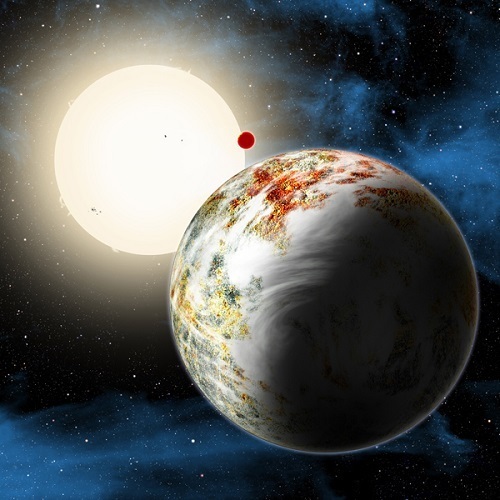
Image: The newly discovered “mega-Earth” Kepler-10c dominates the foreground in this artist’s conception. Its sibling, the lava world Kepler-10b, is in the background. Both orbit a sunlike star. Kepler-10c has a diameter of about 18,000 miles, 2.3 times as large as Earth, and weighs 17 times as much. Therefore it is all solids, although it may possess a thin atmosphere shown here as wispy clouds. Credit: David A. Aguilar (CfA).
The paper on this work notes that “Kepler-10c might be the first firm example of a population of solid planets with masses above 10 M⊕.” And it goes on to discuss the work of Lars A. Buchhave, a CfA astronomer who likewise presented at the AAS meeting in Boston, whose work supports the idea that orbital period correlates with the size at which a planet makes the transition from rocky to gaseous:
If this model is correct, it implies that the core mass limit for gas accretion should increase with orbital period. A recent study from Buchhave et al. (2014, in press.), analyzing hundreds of Kepler candidates, seems to agree with this theoretical prediction. With a period of 45.29 days, a radius of 2.35 R⊕, and a density higher than Earth, Kepler-10c would be at the limit of the transition from terrestrial to gaseous planets observed by Buchhave et al. (2014, in press.). Kepler-10c might be the first object confirming that longer period terrestrial planets can be more massive than ones with shorter periods.
The implication is that Kepler-10c is not likely to be the last ‘mega-Earth’ we find. And this is interesting:
We note that Kepler-131b (Porb = 16 days, 16.1 ± 3.5 M⊕, 2.4 ± 0.2 R⊕, Marcy et al. 2014) lies in the same location of the mass-radius diagram as Kepler-10c. However the mass determination of Kepler-131b is not as robust as for Kepler-10c and more data are needed to confirm the high density of this planet. Measuring precisely the mass of several other long-period Kepler candidates orbiting bright stars could test this speculation. This experiment has just been started as a new observational program on HARPS-N.
Observational errors dominated by photon noise are a problem with a star as faint as Kepler-10, and the paper adds that future transit searches focusing on bright stars will allow the high-quality radial velocity findings needed to measure planetary masses to greater precision. The TESS (Transiting Exoplanet Survey Satellite) mission should provide numerous candidates, as should the ESA’s PLATO mission (PLAnetary Transits and Oscillations of stars).
Meanwhile, we may be learning something new about the early universe, for the Kepler-10 system is some 11 billion years old. Huge, rocky planets could evidently form despite the fact that heavy elements were scarce in this era. Says Sasselov: “Finding Kepler-10c tells us that rocky planets could form much earlier than we thought. And if you can make rocks, you can make life.” Even stars as old as this one, then, shouldn’t be ruled out when we look for astrobiology candidates, a finding that expands the parameters of our search for life elsewhere in the universe.
The paper is Dumusque et al., “The Kepler-10 planetary system revisited by HARPS-N: A hot rocky world and a solid Neptune-mass planet,” accepted for publication in The Astrophysical Journal (preprint).






June 2, 2014
Starflight, Simulation and Deception
In our email conversations leading up to my publishing Human Universals and Cultural Evolution on Interstellar Voyages, Cameron Smith confirmed that there were few anthropologists engaged in studying long-term spaceflight. The same can be said for historians and sociologists, although we do have some prominent names devoting themselves to changing that. Kathleen Toerpe is doing splendid work with the Astrosociology Research Institute (I’m hoping for a new report from her soon in these pages), while Interstellar Migration and the Human Experience (1985) made a determinedly multidisciplinary effort to study our place in the cosmos.
The latter book was actually the proceedings of the Conference on Interstellar Migration held in Los Alamos in 1983, and it remains a storehouse of insights into spaceflight’s effect on humanity. Presenters at the 100 Year Starship symposia have thus far been multidisciplinary as well, with representation from biologists, philosophers, writers and psychologists as well as scientists working the ‘hard science’ fields of propulsion and aerospace engineering. Of course, the place where starflight is most vividly presented from all angles of human experience is in science fiction, which over the years has explored many of the issues raised by, for example, putting a human crew into a multi-generational starship and shooting for Alpha Centauri.
Reading Cameron Smith’s essay, though, had me thinking all weekend about some of the fictional situations great writers have gotten their interstellar crews into. A trip that takes a thousand years inspires thoughts of generations that eventually forget their mission and may not realize they are on a starship. This is familiar turf, worked by Brian Aldiss in his novel Non-Stop (1958), and of course famously portrayed by Robert Heinlein in Orphans of the Sky, which grew out of two novellas in Astounding Science Fiction. Ever the bibliographer, I must mention both: “Universe,” in ASF May, 1941, and the sequel “Common Sense,” which ran in October of the same year.

But if crews that forget where they are is a classic trope of science fiction, somewhat less so is the different kind of ignorance portrayed by J. G. Ballard’s crew in “Thirteen to Centaurus,” a story mentioned by Centauri Dreams commenter Alex Tolley over the weekend. Here the issue is how human crews react to long-haul spaceflight, and we learn early on in the story that the narrative being told by the authoritative ship’s doctor is not exactly what it seems. Here he’s speaking with a young man who has come to believe that his ‘world’ may be a ship:
“You’d more or less guessed before I told you. Unconsciously, you’ve known all about it for several years. A few minutes from now I’m going to remove some of the conditioning blocks, and when you wake up in a couple of hours you’ll understand everything. You’ll know then that in fact the Station is a spaceship, flying from our home planet, Earth, where our grandfathers were born, to another planet millions of miles away, in a distant orbiting system. Our grandfathers always lived on Earth, and we are the first people ever to undertake such a journey. You can be proud that you’re here. Your grandfather, who volunteered to come, was a great man, and we’ve got to do everything to make sure that the Station keeps running.”
Abel nodded quickly. “When do we get there — the planet we’re flying to?”
Dr. Francis looked down at his hands, his face growing somber. “We’ll never get there, Abel. The journey takes too long. This is a multi-generation space vehicle, only our children will land and they’ll be old by the time they do. But don’t worry, you’ll go on thinking of the Station as your only home, and that’s deliberate, so that you and your children will be happy here.”
This all seems familiar for a time, but of course this is J. G. Ballard, in whose hands the tools of science fiction take evocative new form. Normally I would worry about spoiler alerts, but this is a short piece and the reader learns early on that things are not what they seem, so I feel comfortable saying that Dr. Francis is himself lying, that the ship is a long-term Earthbound experiment, and that its crew is being used to study the problems humans will have when we really do send ships to another star. The boy Abel is smart enough to start seeing through even this subterfuge, and our friend Dr. Francis learns he has an agonizing decision to make.

Published in the April, 1962 issue of Amazing Stories — then under the leadership of Cele Goldsmith, whom I consider one of science fiction’s great editors — “Thirteen to Centaurus” was also dramatized by the BBC in 1965 as part of its ‘Out of the Unknown’ series. If you’re not a collector of old magazines, you can track it down in 1963’s collection Passport to Eternity, or more easily still in 2010’s The Complete Stories of J. G. Ballard.
It would be interesting to know how much of an influence the Ballard tale played on Bruce Sterling, whose story “Taklamakan” won a 1999 Hugo Award. Here simulation again comes into play, this time in a remote cave under the Taklamakan desert. There, within three enormous structures each the size of a high-rise building, what one of the characters calls ‘a dry-run starship experiment’ is ongoing, an entire, isolated community having been chosen for the task, which has aspects of both ethnic cleansing and scientific study. The characters ‘Spider Pete’ and Katrinko talk over the ramifications:
“You suppose these guys really believe they’re inside a real starship?”
“I guess that depends on how much they learned from the guys who broke out of here with the picks and the ropes.”
Katrinko thought about it. “You know what’s truly pathetic? The shabby illusion of all this. Some spook mandarin’s crazy notion that ethnic separatists could be squeezed down tight, and spat out like watermelon seeds into interstellar space. . . . Man, what a come-on, what an enticement, what an empty promise!”
“I could sell that idea,” Pete said thoughtfully. “You know how far away the stars really are, kid? About four hundred years away, that’s how far. You seriously want to get human beings to travel to another star, you gotta put human beings inside of a sealed can for four hundred solid years. But what are people supposed to do in there, all that time? The only thing they can do is quietly run a farm. Because that’s what a starship is. It’s a desert oasis.”
And maybe you’ll remember one last story that traded off isolation and experimentation on human crews. The very first episode of Rod Serling’s series The Twilight Zone was “Where Is Everybody?” First broadcast in October of 1959, the story, written by Serling, stars Earl Holliman as a man who finds himself in a town where no one seems to exist, even though evidence of recent occupation is everywhere. We learn at the end that the character Holliman plays, Mike Ferris, is an astronaut in training. He’s been inside an isolation room for almost 500 hours during a simulated trip to the moon. Can the human mind handle deep space in tiny spacecraft?
The message of the show is ‘yes,’ as Ferris looks out and sees the Moon when he is being taken on a stretcher to the hospital. His hallucinations haven’t altered his determination. He yells into the sky:
“Hey! Don’t go away up there! Next time it won’t be a dream or a nightmare. Next time it’ll be for real. So don’t go away. We’ll be up there in a little while.”






May 30, 2014
Human Universals and Cultural Evolution on Interstellar Voyages
Cameron Smith last joined us just over a year ago with an essay on human interstellar migration in the context of biological evolution. Here he turns to issues of culture and change over time. An anthropologist and prehistorian at Portland State University in Oregon, Dr. Smith brings insights he has gained in the study of the early human experience on Earth to the manifold problems confronting us as we head for the stars. His current work on interstellar issues is part of his engagement with Project Hyperion, an attempt by Icarus Interstellar to develop parameters and reference studies for a multi-generational worldship. Be aware of Dr. Smith’s excellent recent volume Emigrating Beyond Earth: Human Adaptation and Space Colonization (Springer-Praxis, 2013), and ponder the synergies that occur between the study of past human migrations and the ongoing cultural and biological evolution of a species aspiring to leave the world that gave it birth.
by Cameron M. Smith, PhD

1. Biological and Cultural Evolution
Any change in the heritable properties of a population over generations is evolution, and we can be sure that the human genome will evolve on multigenerational interstellar voyages, just as it continues to evolve here on Earth today. Even in relatively short, 5-generation voyages, a relatively small gene pool for humanity would have to be carefully composed to prevent collapse in the form of a demographic ‘extinction vortex’ following, for example, a catastrophic plague. This is all clear from elementary population genetics, as I pointed out recently in a technical article in Acta Astronautica1—and it’s important to note that not only will we have to be careful to ensure the genetic health of humanity, but also that of all our plant and animal domesticates and symbionts.2
And, we must remember that genetic information is, in the human lineage, only one channel or stream of adaptive, evolving information; another is culture.3 Culture evolves as surely as biology; like genes, information is replicated (culturally, in the form of ideas), varies in its expression, and those variable expressions of ideas do not all survive to be transmitted to the next generation, but some are more-often copied than the rest; culture, then, does not merely change by a process analogous to biological evolution, it does indeed evolve, albeit in its own way.4 While natural selection has not been entirely buffered out with technology, in human cultural evolution it has largely been replaced by ‘cultural selection’; two examples on opposite ends of a spectrum of selection are propaganda, the deliberate spread of certain information in a population, and censorship, deliberate prevention of the spread of such information. While these are driven by conscious motives, a significant difference from natural selection, which has no intent or purpose, these remain selection in that they alter the frequency of ideas in a culture, and shape its history.
2. How Will Human Culture Evolve Beyond Earth?
We can be sure that our genome will be shaped by new conditions, and some such adaptations, to new gravity environments for example, may be predicted based on what we know of human genetic diversity and adaptability. Can we say anything similar about how human culture might evolve? We can, but we must remember that culture change is much more rapid than biological change. With mass media, an idea can be presented to, and affect the behavior of, billions of people in a matter of seconds. For this reason, culture change is more historically contingent and less orderly, we might say, than biological change. But human behavior is not random, and there are patterns.
For example, in all human cultures a number of basic issues must be solved for sheer survival; an individual needs certain quantities of calories, fresh water and nutrients daily, and the way these are obtained can be strongly conditioned by the immediate resource environment. This has led to humanity, worldwide, developing or evolving cultural traits—“human universals”—that reflect basic problem-solving for the kinds of life form that we are, biologically and socially. An example of this is our subsistence mode. While this differs widely in detail worldwide, all humans have solved basic subsistence needs in one of four main modes of subsistence; foraging (hunting and gathering), pastoralism (raising domesticated animals), horticulture (low-intensity farming and animal domestication) or agriculture (intense farming with complex irrigation and animal domestication). These work for humanity, as opposed to, for example, photosynthesis (not available to [directly] process energy in most animal life). And, the mode of subsistence strongly conditions many cultural variables; for instance, foraging people are normally rather egalitarian, with few instances of social ranking, while among horticulturalists and agriculturalists, social ranking (inequal access to resources by population members) is common. In this case, elementary issues such as social ranking ethos are strongly conditioned by subsistence mode. There are plenty of other factors that play into the shape of a culture, and responsible anthropologists are careful not to be ‘ecological determinists’. But we can learn from such cases.
3. Where to Begin? ‘Human Universals’
Where to begin? It’s easy to be overwhelmed when we begin to think about how human culture will change on multigenerational voyages. To order my thoughts, I have begun to tackle this issue by researching the above-mentioned “human universals”. Again, these are domains of behavioral regulation common to all human cultures. For example, all cultures, in one way or another, regulate sexual behavior, and incest in particular. All human cultures also have basic moral systems for dealing with truth-telling, property theft, and killing. And all human cultures have distinctive languages, styles of bodily decoration, family structure and so on. Remember, the ways that these issues are solved differs by culture (leading to tremendous cultural diversity worldwide), but a set of universal cultural facets is a good place to start when we consider what we might expect to evolve beyond Earth. Table 1 displays some universal cultural domains (over 50 have been identified by anthropologists5), explains the concept of the domain, and provides an example of some alternatives.
Table 1. Common Cultural Domains
DomainConceptExamples
LanguageSpecific spoken and gestural (bodily) systems of communication, including vocabularies and grammars.Some languages assign gender to nouns, while others do not.
EthicsConcepts of right and wrong, justice, and fairness.Some cultures execute murderers, while others do not.
Social RolesRights and responsibilities differ by categories such as age (child, adult), gender (man, woman), and status (peasant, King).Cultures differ in the ages at which people take on certain rights and responsibilities, and specifically what those rights and responsibilities are.
The SupernaturalConcepts regarding a universe considered fundamentally different from daily experience.Different cultures worship different gods, goddesses, and other supernatural entities.
Styles of Bodily DecorationHuman identity is often communicated by bodily decoration, either directly on the body or with clothing.Some cultures heavily tattoo the body while others communicate identity more with clothing styles
Family StructureConcepts of kinship or relations between kin, and associated ideas such as inheritanceSome cultures are polygynous, where males have several wives, and some are polyandrous, where females have several husbands.
Sexual BehaviorRegulation of sexual behavior, including incest rules.Cultures differ in the age at which sexual activity is permitted.
Food PreferencesConcepts of what are appropriate food and drink in certain situations.Some cultures eat certain animals while others consider them unfit to eat.
AestheticsConcepts of ideals, beauty, and their opposites.Some cultures value visual arts more than song, and vice versa.
Ultimate Sacred PostulatesCentral, unquestionable concepts about the nature of reality.Some cultures consider time to be cyclic while others consider it linear.
Rather than generally cast about, then, grasping for what might change over generations of human cultural evolution during future voyages to distant worlds, each of us guided by our own specific ideas and interests, we can systematically use the tools of anthropology and the principles of evolutionary theory to make useful predictions and recommendations to care for the cultural health of interstellar migrant populations.
Such recommendations are often considered ‘meddling’ or ‘social engineering’ by critics, but of course every new law we pass, every tradition we begin to follow, every marriage we sanction or disallow is ‘social engineering’. I take the view that rather than interfering with ‘natural’ culture change, such informed regulation of culture would make for a better future (especially for future human voyagers) than if we left things to ‘fate’. That could too easily go wrong, as we see in the last century of global warfare, where civilization is a thin veneer, nothing more than a set of agreements that, once and easily breached, result in conflict. Thinking clearly about what might befall future generations is not social engineering, it is taking care of the future, as we do by purchasing insurance individually, or working to ensure universal human rights by the passage of international regulations on certain behaviors.6
4. Two Guidelines for Multigenerational Cultural Health
As mentioned, currently I have no clear recommendations, but I am working on many in my research for a forthcoming book, (tentatively titled Principles of Space Anthropology). For example, while we cannot be certain how the regulation of sexual behavior, a cultural universal, will play out in detail off-Earth, we can be certain that it will be adjusted to accommodate a lower population growth rate than we have in many areas of Earth today. If interstellar voyagers are to emphasize no, or very low population growth for some generations, for instance, social institutions and sanctions might well be used to delay impregnation until somewhat later in life than we see, for example, in developed countries today. Marriages themselves might be carried out at a substantially later age than we are accustomed to, and out-of-wedlock births might be significantly discouraged by social means. In one way or another, the finite size and resources of the interstellar vehicle or vehicles would demand a low-or-no population growth ethos for some centuries, and this would surely affect reproductive rights and result in some kind of regulation of sexual behavior. How do we decide what recommendations to make for planning interstellar voyaging? I have at least two guiding principles that will help condition my own recommendations.
First, human culture, and evolution in general, do not typically tolerate rapid and significant structural change. There are many reasons for this, including the fact that bodies and cultural values are somewhat tailored to modern or even ancient conditions, and radical change on a short scale might well dissolve the close connection between the anatomical or cultural feature and the environmental variable. For this reason, I tend not to recommend new and radical social structures or other arrangements for interstellar voyages. Rather, I think it will be best to use social and cultural arrangements that have been familiar to humans for thousands of years; people should not be arranged, then, in new kinds of family structure, or unfamiliar housing such as ships’s barracks, but as families living in familiar environments including villages and towns connected by travel routes that pass through uninhabited areas.
Second, concerning the populations of interstellar vessels, I strongly believe that we should go in large numbers rather than small, barely-sufficient numbers. While some human populations have been able to survive for centuries in the low hundreds, even cut off from other breeding populations, such cases are exceptions to the rule that human populations are interlinked, yielding genetic populations not of just hundreds of individuals, but multiple thousands. This accords with what we see in vertebrates in general, and mammals and primates in particular, where natural and genetically healthy populations rarely drop below 5,000. I also recommend doubling or tripling the outsetting population to guard against the possibility of catastrophe; plague is a particularly terrifying spectre for enclosed populations, and just as passenger aircraft wings are engineered to take not 3 g’s but 10 or more g’s before failure, safety margins should be built into such plans. Since populations alone can significantly affect the shape of cultural universal adaptions, these must be considered together.
The prospect of interstellar voyaging to spread and preserve humanity and civilization is too great a leap for some to make; they call it ‘pie in the sky’, ‘irresponsible dreaming’, ‘escapism’ and plenty else. My anthropological perspective suggests these are all pessimistic critiques from people lacking in creativity or foresight—or even the hindsight that reveals the ruins of each of the ancient civilizations. I am thrilled to be working with Icarus Interstellar to slowly assemble the puzzle pieces required to provide the breathtaking option of long-term space settlement for humanity over the next 100 years.
References
1. Smith, C.M. 2014. Estimation of a Genetically Viable Population for Multigenerational Interstellar Voyaging: Review and Data for Project Hyperion. Acta Astronautica 97(2014):16–29 (abstract).
2. Xu, J. and J.I. Gordon. 2003. Honor thy Symbionts. Proceedings of the National Academy of Sciences 100(18):10452-10459.
3. Whiten, A., R.A. Hinde, K.N. Laland and C.B. Stringer. 2011. Culture Evolves. Philosophical Transactions of the Royal Society B (366):938-948.
4. Gabora, L. 2013. An evolutionary framework for culture: Selectionism versus communal exchange. Physics of Life Reviews 10(2): 117-145.
5. Brown, D.E. 1991. Human Universals. Philadelpha, Temple University Press.
6. For example, see the United Nations’ Universal Declaration of Human Rights, and its use of sanction in many cases to ensure them. Though the UN can be ineffective, its very existence at least demonstrates the will to work in union for the betterment of all.






Paul Gilster's Blog
- Paul Gilster's profile
- 7 followers




